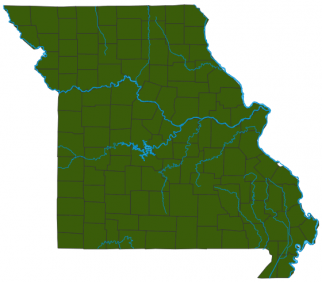Hydras resemble tiny, delicate, elongated sea anemones. They have a columnar or trunklike body, which is structurally a bag (with the mouth at the top). The mouth is rimmed with several long tentacles. Hydra bodies are only two cell layers thick. A sticky secretion at the “foot” enables hydras to cling to a surface. Hydras can glide slowly on their foot, or they can bend over and turn slow-motion somersaults. Colors vary with species; they can be gray, brown, tan, cream-colored, green, orange, whitish, pinkish and “clear.”
Length: stretched out fully, most are about ½ to 2 inches; when contracted, only the size of a speck.

Statewide.
Habitat and Conservation
Hydras can be found in virtually every kind of aquatic habitat, though they are most common in fairly quiet waters such as sunlit pools, where they attach to submerged vegetation and other objects, stretch out their tentacles and “hunt.” They can occasionally grow to large numbers, and when this happens in fish hatcheries, they can be a serious threat to newly hatched fry.
Food
Hydras wave their tentacles slowly in the water. When food touches a tentacle, special stinging cells discharge to help subdue the prey. The tentacles draw the food into the hydra’s mouth. Any tiny animal is fair game, including worms, small crustaceans, baby fish, young insects and larval mollusks. One species, the green hydra (Hydra viridissima), like the saltwater corals and anemones, holds symbiotic algae in its tissues and derives nutrients from the algae.
Life Cycle
Hydras usually reproduce asexually by “budding”—a new hydra starts as a “bud” forming on the side of a hydra’s body; it grows and eventually breaks away as a clone of the original. Some species reproduce sexually, releasing sperm into the water that can reach eggs on another hydra. The eggs form a tough coating and can survive drought and freezing. Sexual reproduction usually only happens in harsh environmental conditions or right before winter.
Human Connections
Hydras, though very small, can be kept in aquariums if you feed them the small worms, water fleas and miniature, planktonic prey they need. Unlike saltwater corals and anemones taken from the wild and sold at pet stores, our freshwater hydras are numerous and free.
Ecosystem Connections
Most of us know that ecosystems are based on the tiny plants and animals that form the base of the “food chain.” Hydras form an important link between the tiny animals they eat, and their own predators—fish, crayfish and aquatic insects—which are big enough for us to “see.”





















